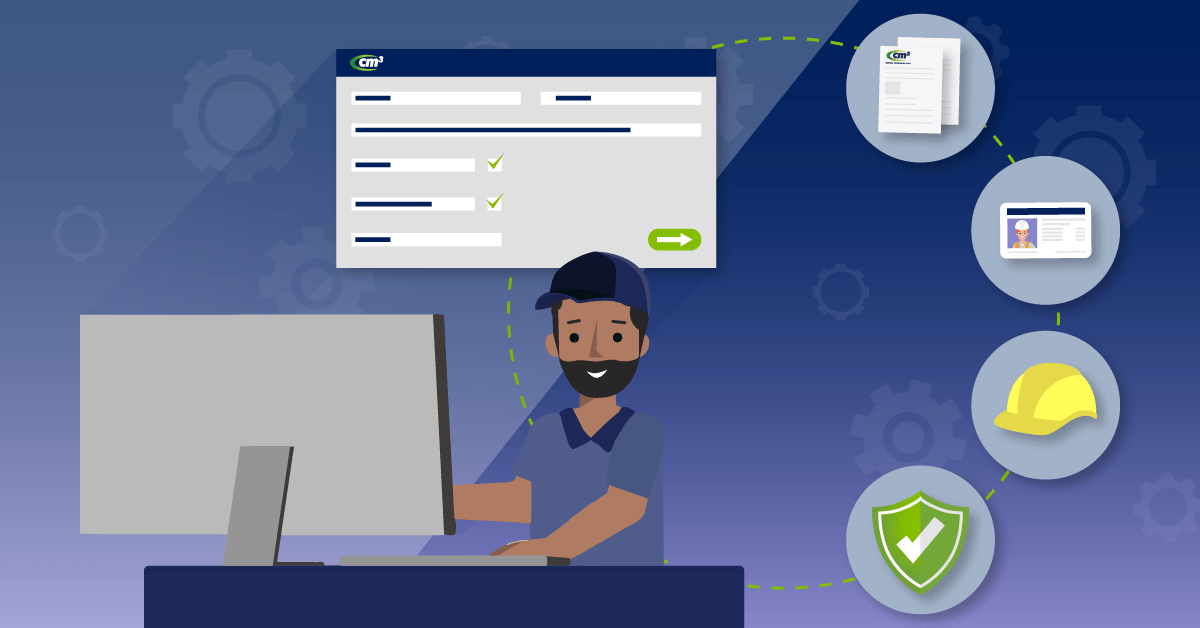Cm3 is the Contractor Management and Prequalification partner of hundreds of organisations, and central to the ecosystem is Cm3’s Assessment Process. These assessments are designed to demonstrate to clients that a contractor has sufficient Work, Health and Safety (WHS) capability to carry out the client’s scope of work safely. The assessment addresses the major aspects of a WHS management system, and there is a minimum standard the contractor must meet. The focus is on understanding how WHS is managed in an individual business and applying a thorough assessment process to establish a satisfactory level of compliance. Cm3’s assessments are conducted by qualified and experienced Health and Safety professionals.
What to Expect – A focus on processes & compliance
When joining Cm3, a contractor will put together a Business Risk Profile (BRP) which is indicative of their type of work, and the risks involved. Cm3 Assessors use the BRP in combination with the assessment evidence supplied by the contractor to build an understanding of the contractor’s operations and the scope of work they undertake for their client/s.
Contractors are asked to detail the nature of work done in one of the following ways:
- Selecting the risk categories associated with the known/expected Scope of Work (SOW) for their Cm3 client/s
- Selecting the specific activities done within each risk category on the BRP to show their full range of capabilities
What do Cm3’s Assessors look for?
Upon submission of an assessment, the Assessor will first look to see if the risks selected in the BRP match those that appear in the contractor’s assessment evidence. There will often be some discussion between the Assessor and the contractor about risks that are noted in Safe Work Method Statements (SWMS) or other evidence, but have been omitted from the BRP, incorrect selections made, or risks that have been included in the BRP but are not relevant to the work.
When a contractor uses a generic SWMS, it can make this task more difficult as they typically contain a lot more than is needed. When the Assessor sees SWMS or other types of generic risk assessment submitted as evidence, they expect to see lots of “red pen” and notes in the document. If contractors do not edit their generic SWMS/risk assessments to cross out the parts they are not using, OR do not advise the Assessor of activities that are not applicable, this will result in the Assessor having to return the submission for clarification. This can cause a bit of back and forth discussion and may delay the assessment process.
Overall, Cm3 looks for evidence showing that the contractor:
- Understands what risks they may find and what risks they may bring to site
- Has the necessary competencies, credentials, training and licences to complete the work
- Will bring tools and equipment that are correct for the job and fit for purpose
Evidence
The evidence guides provide information on the criteria a document must meet to be a valid piece of assessment evidence. If the contractor is unsure, a question mark icon at the end of each question can be clicked to open a dialogue box that tells the contractor the evidence test for that particular element of the compliance assessment.
For more assistance, Cm3’s online HELP section, accessed via the NEED HELP button to the right of the screen, contains articles, guides, video tutorials, templates and tools for contractors on all assessment subject matter by category. In some places in the assessment, there are links to take the contractor directly to the relevant article. Cm3 is committed to continually upgrading assessment screens to include these links for every element. If the contractor still has specific questions after accessing this, a call-back from their Assessor will help them through their remaining tasks. The contractor can request a call back from the Support team via Live Chat.
Assessor Feedback
Feedback is given to a contractor when an Assessor needs further information or needs to clarify information provided. This might be because evidence is incomplete, incorrect or needs improvement. It may also be when it is clear a contractor has left something out or has included too much in their BRP. When feedback is given, the assessment is returned to the contractor for them to action it. If they don’t do this promptly, the assessment can remain parked in the system until they do. Cm3 does send out reminders to respond to feedback, and these should be actioned quickly by contractors to avoid delays in the process.
Clients can keep track of their high value contractors using their weekly exception reports to see those that may need some encouragement to respond and complete the process. It is encouraged that clients and contractors communicate regularly, and client involvement can help the contractor progress by reinforcing the importance of the process to them.
It is often the case that the individuals in a business who are tasked with completing Cm3’s Assessment Process are operational and not safety people. They may have lots of competing priorities. The Cm3 Assessor team understands this, and will always try to give clear feedback and help them through the process to achieve prequalification.
Additional help for Cm3 clients
In addition to the contractor HELP section, Cm3 has also developed a comprehensive HELP section for clients. The client HELP section contains reference material on every aspect of Cm3 and how to use the features. For additional user needs and other specific requirements, Cm3’s dedicated Customer Success Team is available to assist the client further.
